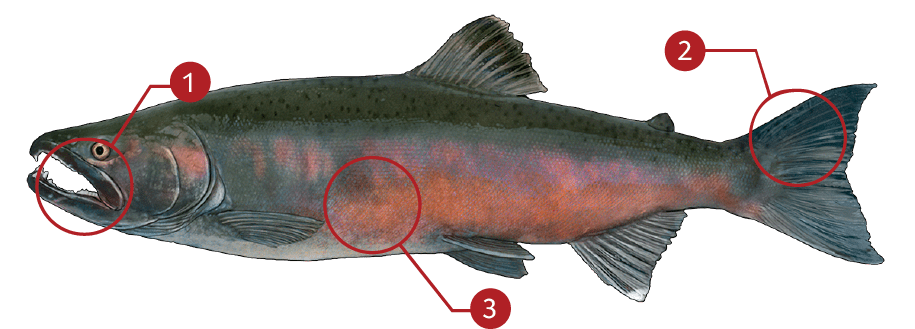COHO SALMON
How to identify a Coho Salmon
This is a silvery fish when at sea and has small black spots on the back, upper sides, base of the dorsal fin, and upper lobe of the tail. It can be distinguished from both the chinook salmon and the steelhead, or rainbow trout by the fact that it only has spots on the upper half of the tail while the latter two have spots over the entire tail. Also, it generally has pale or white gums and a black mouth (some Great Lakes specimens may have gray or black gums) while the chinook always has black gums and a black mouth.Spawning females change very little. Males tend to turn somewhat darker on the back and duller on the sides. During the spawning run they may also exhibit a red stripe along the sides, like rainbow trout. The males develop a kype, both the upper and lower jaw becoming extended and hooked toward each other so that it becomes impossible to close its mouth.
Where to catch Coho Salmon
The Coho Salmon is endemic to the Pacific Ocean from Point Hope, Alaska south to Monterey Bay, California. Infrequently, it has been reported at sea as far south as Baja California. It has been transplanted into the Great Lakes and into freshwater lakes in Alaska and along the U.S. Pacific coast as well as into Maine, Maryland, and Louisiana.
IDENTIFICATION

| |
Pale or white gums and a black mouth (some Great Lakes specimens may have gray or black gums) |
| |
Small black spots on the back, upper sides, base of the dorsal fin, and upper lobe of the tail. |
| |
During the spawning run they may also exhibit a red stripe along the sides |
TARGET AREAS
|
|
Acknowledgements: We thank TAKEMEFISHING.org (www.takemefishing.org), Wisconsin Department of Natural Resources, Indiana Department of Natural Resources for their contributions to these FISH FACTS.

